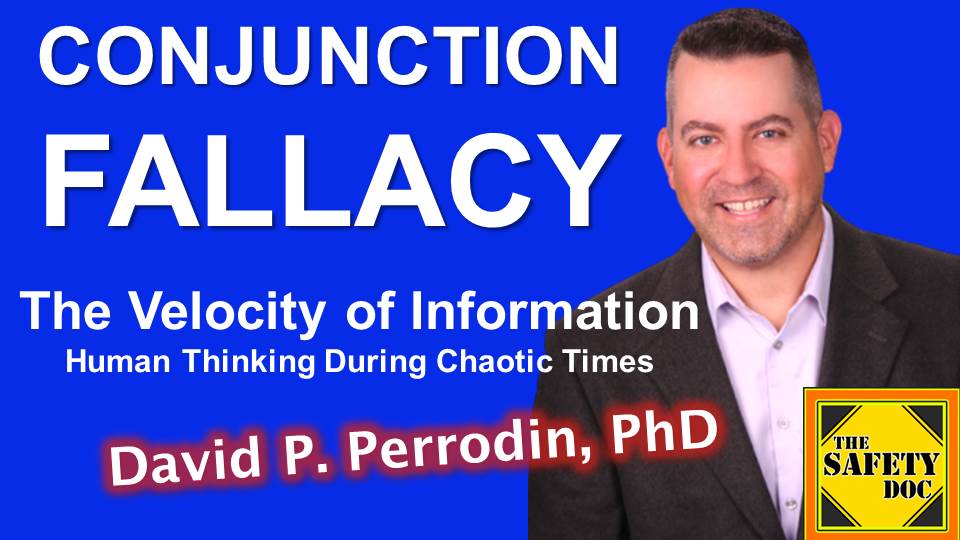Conjunction Fallacy | Why We Believe Elaborate Reports | Taming Human Bias | SDP172
[Podcast] The `Conjunction Fallacy’ is a fallacy or error in decision making where people judge that a conjunction of two possible events is more likely than one or both of the conjuncts. Here are some examples. EXAMPLE ONE: Doc is a Wisconsinite who went to the store and bought tofu, eggplant, broccoli, and frozen meatless lasagna. Is it more likely that Doc is a Wisconsinite or a Wisconsinite who is a vegetarian? EXAMPLE TWO: Doc has a PhD or Doc has a PhD and reads the Wall Street Journal. EXAMPLE THREE: Katherine drove to a party in South Dakota in a Rolls Royce or Katherine drove to a party in South Dakota in a Rolls Royce as is a millionaire. In each example, the correct answer is the statement with fewer conjunctions – even though the conjunctions tend to create a sense of a more believable statement.

DIRECT LINK to MP3 of this Episode: https://tinyurl.com/SDP172-AUDIO
CONJUNCTION FALLACY: MR. F. HAD A HEART ATTACK. Excerpt from pages 51-52 of the book The Velocity of Information: Human Thinking During Chaotic Times (2022). In 1983, world-renowned psychologists Amos Tversky and Daniel Kahneman published a ground-breaking study on intuitive human cognitive bias (cite 1). They showed that when subjects are asked the likelihood of several alternatives, including single and joint events, they often make a conjunction fallacy. That is, they rate the conjunction of two events as being more likely, or more plausible, than only one of the constituent events. They presented the following fabricated scenarios to 115 undergraduates at Stanford University and the University of British Columbia: A health survey was conducted in a representative sample of adult males in British Columbia of all ages and occupations. Mr. F. was included in the sample. He was selected by chance from a list of participants. Which of the following statements is more probable? (A) Mr. F. has had one or more heart attacks. (B) Mr. F. has had one or more heart attacks and he is over 55 years old. This seemingly transparent problem elicited a substantial proportion (58% selected option B) of conjunction errors among statistically naive respondents (cite 2).
WE ARE PRONE TO BELIEVE VIVID STORIES. This example, and countless like it, reveal that we are all subject to the conjunction fallacy, where we regularly violate the laws of probability due to a vivid story. This error in decision-making happens when people judge that a conjunction of two possible events is more likely than one or both of the conjuncts. Innate human reasoning infers that the addition of more details increases the probability of two events occurring simultaneously. (It is also an explanation for why liars tend to add additional or even excessive detail to a given lie in order to predispose the recipient to accepting the lie as truth.) However, the more detailed outcome is just that, more detailed. It is not more plausible or more likely. In fact, the probability of the two events occurring together (in conjunction) is always less than or equal to the probability of either one occurring alone. In other words, a conjunction cannot be more probable than one of its constituents.
CONJUNCTION FALLACY DURING THE PANDEMIC. Which of these statements might you have deemed to be most probable on March 25, 2020? (A) The governor has ordered people to stay home. (B) The governor has ordered people to stay home, and state highways are closed. Previous studies of conjunction statements imply that the majority of people presented with these statements would select B. Fortunately, conjunction bias collapses in on itself when too many conditions are stated. Most people are able to identify the mental trickery of a statement with a dozen conjunctions. It no longer makes sense from a face validity standpoint.
CITATIONS: (1) Tversky, Amos and Daniel Kahneman. “Extensional Versus Intuitive Reasoning: The Conjunction Fallacy in Probability Judgment.” Psychological Review, 90 (1983): 293–315. (2) Tversky and Kahneman, Extensional Versus Intuitive Reasoning, 293–315.
This is episode 172 of The Safety Doc Podcast published on 03-08-2022. This podcast and blog post represent the opinions of David P. Perrodin and his guests to the show. The content here is for informational purposes only. Please consult with your safety professional regarding the unique needs of yourself or your organization.
FOLLOW
- Watch this episode on “The Safety Doc” YouTube channel https://tinyurl.com/SDP172-VIDEO
- Listen to this episode on PodBean MP3 https://tinyurl.com/SDP172-AUDIO
- Apple Podcasts http://tinyurl.com/SafetyDocApplePodcasts
- SAFETY DOC WEBSITE & BLOG safetyphd.com
- Follow David & The Safety Doc Podcast on Twitter @SafetyPhD
- Email Dr. Perrodin thesafetydoc@gmail.com
Purchase Dr. Perrodin’s books
School of Errors – Rethinking School Safety in America
The Velocity of Information – Human Thinking During Chaotic Times
